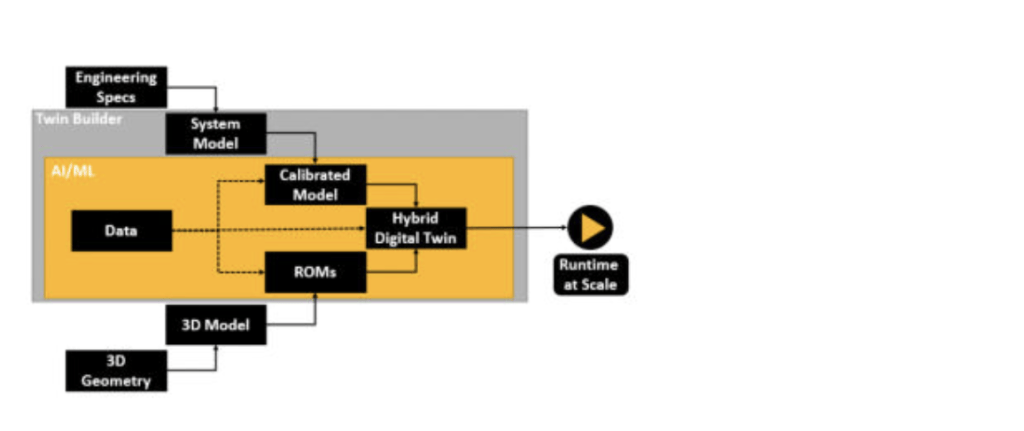By Shivajyoti Bhattacharjee, Vice President – Healthcare & Life Sciences, Cybage
Digital Twins: A digital twin is a virtual representation of real-world entities and processes, synchronized at a specified frequency and fidelity, according to the Digital Twin Consortium. Engineers generally take a data-driven or physics-based simulation approach to create digital twins. Today, we have physics simulation builder tools like Twin Builder from Ansys.
With AI/ML integration, engineers can merge data and physics to create the best possible twin: the hybrid digital twin.

Fig. 1. Diagram shows integration of artificial intelligence/machine learning and Twin Builder
AI/ML area is just getting started; novel algorithms are coming out all the time. We constantly watch the latest, newer methods, track what is happening in the AI/ML community and apply it to simulation.
Data-driven models alone can provide roughly 80% accuracy, while simulation-based models increase that number to 90%. But combining the two methods as having the best of both worlds — produces nearly 98% accuracy results.
Twin Builder solver technology is used for industrial use for multidomain system simulation. Further, the multi-technology platform pairs with physics-based simulation technology to transport the detail of 3D simulations — for example, leveraging structural, fluids, electromagnetic, or semiconductor products to model mechanical assemblies — as reduced-order models (ROMs) into the system framework to produce accurate and more efficient system-level models.
Structured around the following pillars, we can have a multilayered approach to innovation.
- Numerical methods
- Artificial intelligence/machine learning (AI/ML)
- Digital twins
- Meshing/geometry based on Graph Data modeling
- High-performance computing (HPC)
- Visualization and user experience/user interface (UX/UI)
- Cloud
- Solutions (e.g., autonomy, electrification, 5G)
- Platforms/workflows
- Model-based systems engineering (MBSE)
- New vertical health care
Health Care Horizon
By leveraging digital twins and AI, we can advance toward a new vertical health care approach through a six-phase plan, which begins, of course, by building and strengthening collaborations with academic and clinical partners. Next is digital transformation, in which health care modeling tasks are simplified and integrated into digital workflows, taking advantage of simulation solutions such as Twin Builder. Building on these Multiphysics models, patient-specific virtual organs can be deployed as design platforms.
While the first three stages have been implemented in several academic and clinical settings, the latter three phases will require widespread adoption of such innovation.
As a fourth phase, the primary objective is to reduce, refine, and replace clinical trials with faster, cheaper, and safer in silico clinical trials, i.e., simulation or computational modeling. Once this becomes routine or widely received, the next mark is to deploy and apply patient-specific models to billions of annual surgical and medical procedures through accessible, easy-to-use clinical applications. The final phase — and ultimate goal — is to achieve this level of widespread adoption and fully integrate patient-specific digital twins, or personal digital avatars (PDAs), into the mainstream to prevent diseases.
Digital Twins & AI for Vertical Health: Six-Phase Plan
- Collaboration with academic and clinical partners
- Digitalization of health care modeling tasks
- Creation of patient-specific virtual organs as design platforms
- Reduce, refine, and replace clinical trials within silico clinical trials
- Deploy patient-specific clinical applications in medical procedures
- Market digital twins of device and equipment, and initiate patient-specific digital twins — Personal Digital Avatars (PDAs)
The Editorial Team at Healthcare Business Today is made up of skilled healthcare writers and experts, led by our managing editor, Daniel Casciato, who has over 25 years of experience in healthcare writing. Since 1998, we have produced compelling and informative content for numerous publications, establishing ourselves as a trusted resource for health and wellness information. We offer readers access to fresh health, medicine, science, and technology developments and the latest in patient news, emphasizing how these developments affect our lives.









